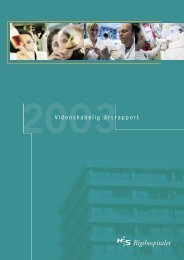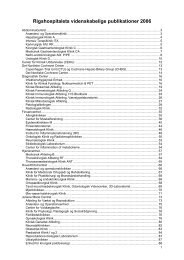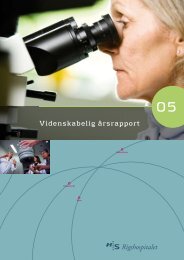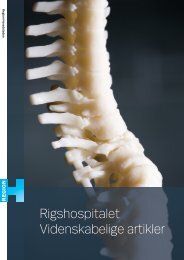View - CTU
View - CTU
View - CTU
Create successful ePaper yourself
Turn your PDF publications into a flip-book with our unique Google optimized e-Paper software.
OOOOE<br />
Volume 103, Number 4 Bj¢mda! et al. 573<br />
Table I. The distribution of male and female general dental practitioners' self-assessments of level of endodontic<br />
knowledge and skills (N = 470)<br />
Excellent<br />
Endodontic topics Tota/(%) M F<br />
Pulpal pathology 156 (34.9) 87 69<br />
Microbiology 39 (8.7) 14 25<br />
Clinical diagnostics 310 (68.9) 162 148<br />
Injecting local anesthesia 361 (80.0) 200 161<br />
Emergency treatment 333 (74.8) 182 151<br />
Root canal preparation procedure 182 (40.4) 109 (1 *) 72<br />
Root filling procedure 151 (33.5) 95 (1 *) 55<br />
Prognostic factors 114 (25.7) 70 44<br />
M, male; F, female.<br />
*Number of responds not specified in relation to gender.<br />
Satisfact01y<br />
Nonsatisfactmy<br />
No<br />
Tota/(%) M F Tota/(%) M F influence<br />
263 (58.8) 142 120 (l*) 28 (6.3) 7 21 23<br />
225 (50.4) 127 97 (1 *) 182 (40.8) 96 86 24<br />
138 (30.7) 75 62 (l*) 2 (0.4) 1 1 20<br />
85 (18.8) 38 46 5 (1.1) 0 5 19<br />
107 (42.0) 53 54 5 (1.1) 2 3 25<br />
245 (54.3) 115 130 24 (5.3) 14 10 19<br />
273 (60.5) 135 138 27 (6.0) 19 8 19<br />
296 (66.7) 150 145 (1 *) 34 (7.7) 15 19 26<br />
574 Bj¢mda<br />
more weekly<br />
having less ('<br />
GS that toot!<br />
endodontic 01<br />
GDP self-as!<br />
knowledge<<br />
In Table I<br />
and clinical<br />
were, in gern<br />
GDPs as be<br />
"microbiolog<br />
nonsatisfacto<br />
metric rank correlation 16 ) were used to characterize the<br />
degree of association in these cases. The GDP group<br />
opinions and the gold standard were compared by Wilcoxon<br />
tests, because a normal distribution assumption<br />
was clearly rejected (significance level set at P < .05).<br />
RESULTS<br />
The overall response rate was 79.2% (N = 475). Five<br />
questionnaires were returned blank and 26 were only<br />
partially completed. The major reason given for not<br />
responding was that the dentists felt too busy to complete<br />
the form. In addition, 10 practitioners questioned<br />
the anonymity (the return envelope was coded) and did<br />
not want to take part in the study. Fifty-three percent of<br />
the responders were males. However, among younger<br />
dentists, a majority were females. Seventy percent of<br />
the GDPs were practice owners, and 88% worked 27<br />
hours or more per week. Fifty-two percent reported to<br />
have 2 to 4 weekly endodontic visits and 28% had more<br />
than 5.<br />
GDP responses on the prognostic factors<br />
There was a large variation within almost all the<br />
GDP responses (Figs. 1-3). In general, the GDP group<br />
response assessed many preoperative factors as having<br />
an important influence on endodontic outcome with<br />
visual analog scale scorings >50. Tooth type was assessed<br />
by the GDP as the most influencing preoperative<br />
factor on endodontic outcome (Fig. 1). Results from the<br />
operative and postoperative factors are disclosed in<br />
Figs. 2 and 3.<br />
Comparisons between the GDP group response<br />
and the gold standard<br />
The GDP group response, in 9 of 12 preoperative<br />
factors, significantly overevaluated the influence on<br />
prognosis as compared with the gold standard (GS; Fig.<br />
!). In contrast, the GS indicated a high influence for<br />
only 2 factors: periapical status and infected root canal<br />
(Fig. 1 ). The use of "antibiotic" had the least influence<br />
of all the preoperative factors according to the GS.<br />
GDP group response and sex<br />
Female GDPs assessed a significantly higher influence<br />
on endodontic outcome than males in relation to<br />
the following preoperative factors: tooth type<br />
(ANOV A, P = .0067), periapical status, fever and<br />
localized swelling in relation to tooth (ANOV A, P =<br />
.0021), and fistula (ANOVA; P < .0001). Females also<br />
assessed root filling extending out of the apical foramen<br />
as having a higher influence on outcome than males<br />
(ANOV A, P = .0079). The female GDPs agreed with<br />
the GS that periapical status influences the treatment<br />
outcome, whereas male GDPs had a significantly different<br />
group response than compared with the GS (Wilcoxon<br />
test, P = .0426).<br />
GDP group response and age<br />
Younger aged GDPs versus older scored a higher<br />
influence on treatment outcome as shown by the negative<br />
correlations in relation to status of the pulp (-y =<br />
-0.16; P = .000) and periapical status (-y = -0.12; P<br />
= .02). Moreover, younger GDPs also assessed a<br />
higher influence for use of interappointment dressing in<br />
relation to the treatment of necrotic infected pulp ( 'Y =<br />
-0.27; P = .000) and the presence of bacteria in the<br />
root canal after instrumentation (-y = -0.19; P = .004).<br />
GDP group response and weekly endodontic<br />
visits<br />
GDPs with relatively more weekly endodontic visits<br />
increased the assessments of influence on the treatment<br />
outcome expressed as positive correlations in relation<br />
to status of the pulp (-y = 0.12; P = .026), periapical<br />
status (-y = 0.23; P = .000), and working length (-y =<br />
0.18; P = .009). Moreover, GDPs having relatively<br />
Correlation<br />
endodontic<br />
Females 2<br />
themselves a<br />
thology (-y =<br />
(-y = 0.23; p<br />
mechanical r<br />
given the sa<br />
procedure ( 'Y<br />
prognostic fi<br />
Correlation<br />
and level o1<br />
The most<br />
a satisfactor<br />
-0.13; p =<br />
.005), where<br />
= .001) and<br />
0.40; p = ,(<br />
Correlation<br />
status and I<br />
skills<br />
Practice c<br />
higher satisJ<br />
= -0.30; p<br />
p = .005),<br />
.029), and i1<br />
.000).<br />
Correlatior<br />
hours and<br />
skills<br />
Know led;<br />
tive of empl<br />
assessed hi~<br />
most hours<br />
per week(;








